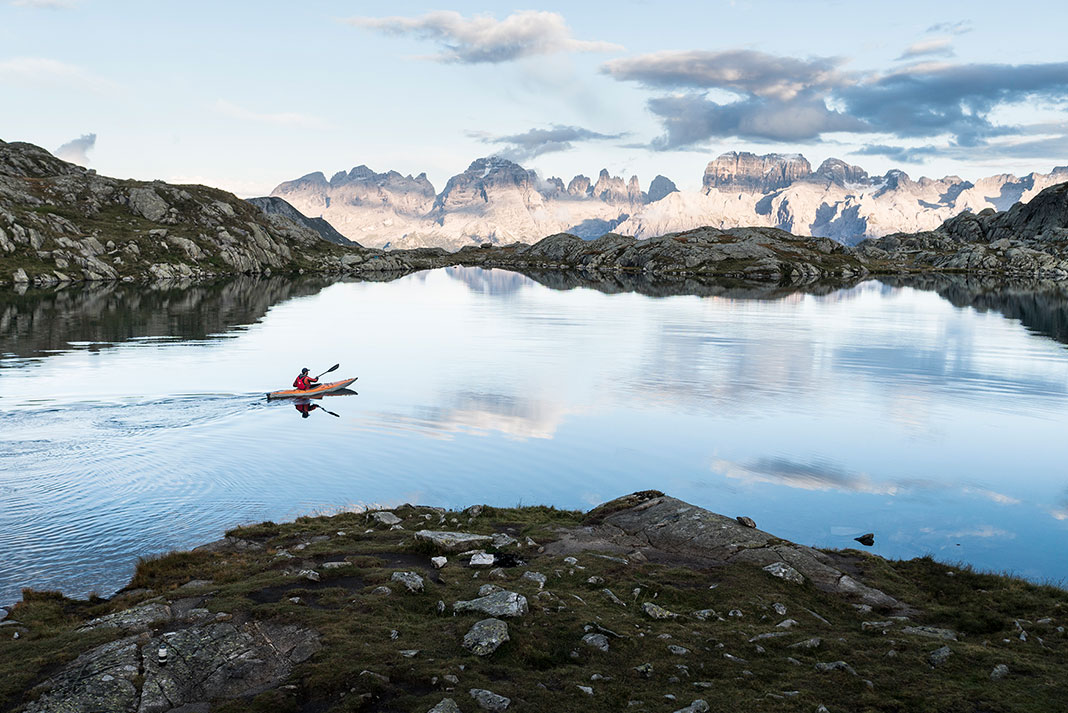The greatest innovation to paddlesports in the past two decades is perhaps the modern packraft. Sure, ultralight inflatable paddle craft have been around as survival gear since World War II. But it wasn’t until the turn of the millennium, when Alpacka Rafts founders Sheri and Thor Tingey introduced the concept of a recreational packraft—a compact, inflatable raft that you can carry in a backpack—that these ultra-portable boats really gained momentum.
Over the past 20 years, the packraft has gone from a single utilitarian design to countless specialized ones. In that time, packrafts have reshaped what we think of as a portable paddling craft and opened up accessibility to paddling at two extremes of a spectrum.
First, packrafts have allowed for unprecedented ultralight paddling expeditions—trekking, climbing, even biking to remote areas in order to run streams and pass from one drainage to the next. Imagine for a moment if Lewis and Clark were able to carry packrafts across the continental U.S.
At the other end of the spectrum is accessibility to paddlesports in general. A packraft is the most packable solution we have seen in paddling yet. These boats weigh just 3-15 pounds and some roll up to nearly the size of a 1-liter water bottle. That makes it possible for even the most space-strapped city dweller to own a boat and paddle regularly.
Add their stability and fun versatility for all types of water, and you have one of the lowest barriers of entry to the sport. Throw a packraft in the car and you could be fly fishing on an alpine lake or floating down a scenic stretch of moderate whitewater. Toss it on your back or bicycle, and you could be walking or pedaling from your apartment to a tucked-away bay in the city.
Packrafts are both dainty and durable. These lightweight inflatables can get blown across flatwater like a dancing leaf, but they also hold their own navigating some of the world’s toughest whitewater. Packrafts have opened the door to paddling experiences both extreme and close to home. Most notably, packrafts are durable enough to survive rugged and remote use. They are much more durable and capable than the similarly shaped vinyl boats that are widely and cheaply available at big-box stores.
So which is the best packraft? There are a lot of options out there, including sub-3-pound ultralight models for remote-access flatwater paddling and heavy-duty, class V-capable packrafts for whitewater expeditions. There are packrafts for both solo paddlers and those who want to bring along a pet or child, as well as tandem packrafts for two paddlers.
In this article we’ll provide some guidance on how to select the best packraft for your paddling goals.
Top picks: Best packrafts for 2025
The following packrafts have received the highest star ratings by reviewers in our Paddling Buyer’s Guide.
Best Packrafts

PackLite Kayak

Nirvana Self-Bailing

Backwoods Expedition 85

PackLite+ XL

Twain

Rogue R-Deck

Nirvana Spraydeck

Purist 65

PackLite+

Recon Spraydeck
Shopping for a used packraft?
Buying a packraft isn’t exactly cheap, but there’s good news if you are looking to get into packrafting on a budget. The growth of packrafting over the past 15 years means there is now a market for used packrafts. Whether someone is upgrading their setup, or tried it out and decided it wasn’t for them, buying a used packraft is a great way to score a deal and get into the sport on a budget. Some manufacturers even offer refurbished packrafts at prices much lower than comparable new boats.
When buying a used packraft, keep these tips in mind before committing to a purchase.
Do your research
When you come across a Craigslist packraft listing, the price may be attractive but the details may be vague. When you’re shopping secondhand, a packraft can range from a high-end, whitewater-capable inflatable to a glorified pool toy with a catchy name. Get all the details from the seller including the brand, model and size. This way you can research the packraft to find out its intended use.
Also, ask the seller how and where they used the packraft. This may give you a gauge on how the boat is intended to be used and what kind of use it has received.
Check for wear and tear
Packrafts are durable but punctures, leaks, damaged valves and mold or mildew are possible if the boat has been poorly cared for or improperly stored. Unpack the packraft; see if there are any holes or patches on the floor.
Check that all valves are in working order, opening and closing cleanly. If there is a cargo zipper, check that the zipper slides to completely open and closed, and isn’t jammed or corroded.
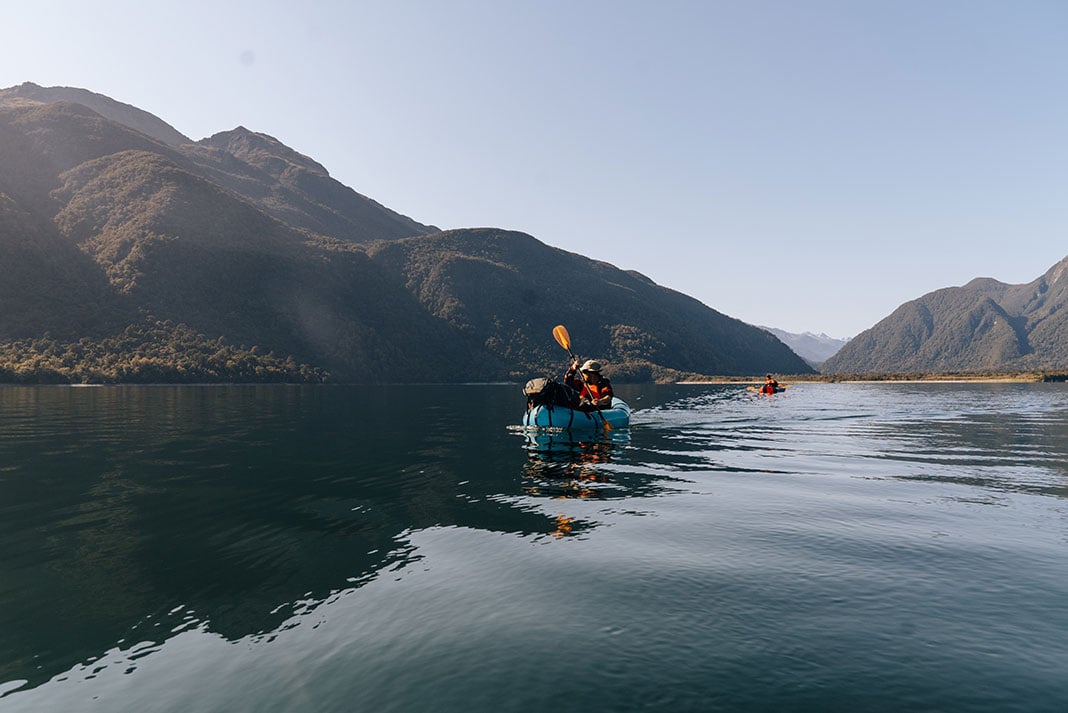
Inflate and inspect
Before walking away with a used packraft, inflate the boat to be sure it holds air. Fully inflate each chamber of the packraft. Once you have it inflated, give the packraft another inspection. Look for any heavy wear or abrasions, especially on the floor, outer tubes and around any rigging. Run your hands around the packraft to feel for air leaks, especially around seams and valves.
Let the packraft sit inflated for a few minutes. This is a great time to have a conversation with the seller. Ask questions, learn about the raft and the sport in general. After some time has passed, go back and see if the packraft feels softer than when you initially inflated it.
If it does, this may mean there is a hole in the boat or leak at a valve or zipper. This is not necessarily a deal breaker if it is something you can repair (or have professionally repaired by the manufacturer), but should be factored into negotiating a lower price.
Test paddle
The best way to know if a packraft is comfortable for you, or if you’ll actually enjoy using one, is to get it on the water. Ask the seller to meet at a launch site and take a few minutes to try out the packraft. Be sure to bring a paddle, PFD and proper paddling layers if they are not part of the sale.
Packraft buying guide
Packrafts come in a variety of shapes, sizes and intended uses. If you’re wondering how to choose a packraft, start with where and how you want to use it. Some simple packrafts are meant for a quick paddle across a pond, while other more rugged and complex designs are intended for difficult whitewater or touring.
All packrafts are inflatable and all are compact crafts that can be carried in a pack. But features like spray decks, self-bailing floors or zipper-accessed storage compartments are options that can increase the versatility, and price, of a packraft.
Packrafts are known for their bulbous sterns and kicked-up bow rocker (the bottom curves up at the nose to ride over waves) for increased performance on whitewater. But as packrafts continue to evolve for different uses and user groups, they’ve begun to take on many shapes.

Keep in mind that the same packraft model may be available in a variety of sizes to accommodate different sized paddlers. Make sure you are getting a packraft sized for you. Too small a boat, and you’ll sit lower in the water and be more cramped for longer paddles. In whitewater, a too-small boat capsizes more easily. Too big and it will be hard to effectively maneuver the boat, and you’ll spend a lot of extra energy to do so.
Consider the following advice to help you find the best packraft for your upcoming paddling season.
Packraft construction and materials
Packrafts are commonly made out of lightweight, durable materials. The packraft fabric most often used for the sidewalls (or tubes) and floor is reinforced, polyurethane-coated nylon, and can also be blended with other lightweight materials for increased durability. PVC is also used on cheaper packrafts.
Generally, a lighter packraft will mean a lighter fabric layup. This is important to keep in mind when deciding on how you will use a packraft.
A packraft under 10 pounds is best for ultralight expeditions, and can usually endure use on milder whitewater rapids.
If you intend to use your packraft on a regular basis you likely want a heavier layup in the 10- to 15-pound range. This weight will have more durability as a daily paddler and for running more difficult whitewater.
The size of your packraft may also affect its weight. Packrafts come in a variety of lengths. Some are as short as six feet for an ultralight expedition setup. At the other extreme, there are now packrafts exceeding 12 feet for touring use on flatwater. However, you can expect the average packraft to fall around 7-8 feet long.
When looking at any packraft model, also be sure to check the manufacturer’s recommended weight capacity. In addition to paddler weight, consider how much gear you’ll be carrying, or if you will have a bike strapped across the bow.
Open or closed deck
Packrafts essentially come in two styles: open deck packrafts and closed deck packrafts, also known as whitewater decks.
An open deck packraft is very similar to the idea of an inflatable kayak or sit-on-top kayak. The paddler sits between the side tubes on the floor of the boat, often on an inflated seat, with their legs fully exposed. These packrafts tend to be the lightest in weight and are the easiest to enter and exit.
Because it’s easy for splashing waves to enter the raft, many open deck packrafts are best suited to flatwater, slow moving rivers and mild whitewater. If you want an open deck packraft for more challenging whitewater, choose a model with a self-bailing floor (see below).
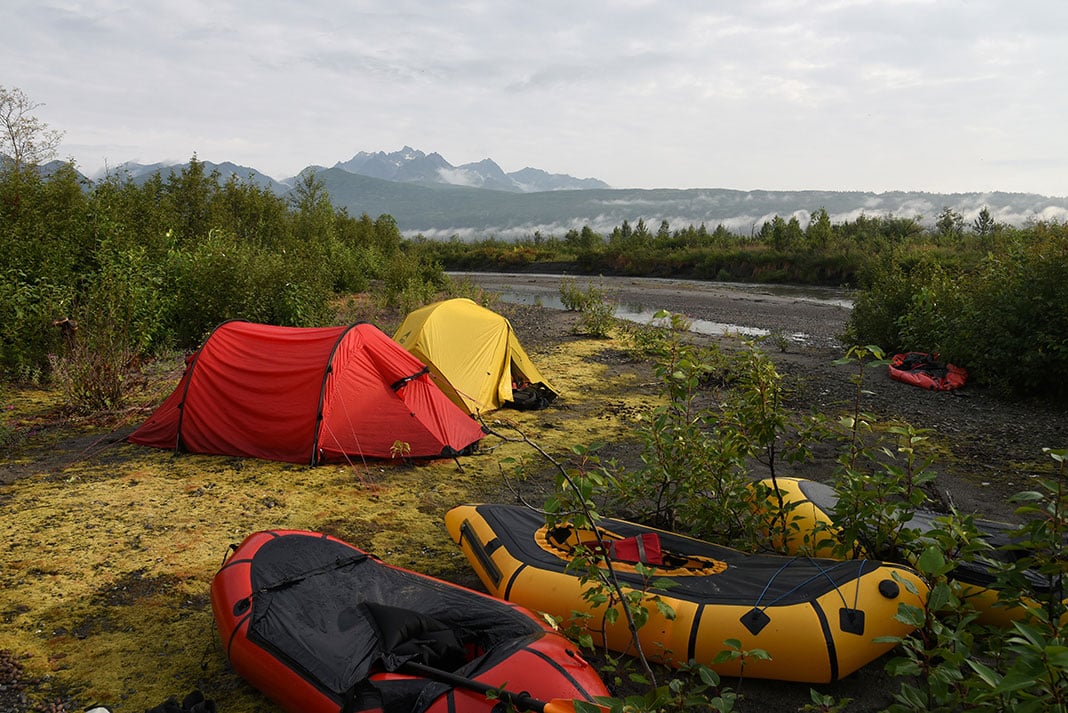
A closed deck packraft, or packraft with a whitewater deck, has a thin sheet of wave-deflecting fabric stretched across the top. A closed deck keeps waves from splashing into the packraft, and is ideal for colder water and more difficult whitewater. The paddler slides into the cockpit opening, similar to a sit-inside kayak, with their lower body enclosed beneath the deck.
So-called “cruiser” decks attach with Velcro and are removable so the packraft can be paddled open or closed, but are better suited to calmer waters since they are less waterproof than a true whitewater deck.
Some closed deck packrafts can be used with the paddler wearing a spray skirt to keep the packraft dry inside. The spray skirt cinches snugly around the paddler’s waist and seals around a cockpit rim, usually created with a flexible pipe formed around the cockpit opening. With a spray skirt and interior outfitting such as thigh straps and foot braces, an experienced paddler can run difficult whitewater in a packraft and even perform a roll to right the packraft should it flip over.
Sealed or self-bailing floor
In addition to deciding between open and closed deck packrafts, you can also choose the type of floor, which will affect how much the packraft weighs and where it can be used. When it comes to choosing a floor on your packraft there are two main options: a sealed floor and a self-bailing floor.
A sealed floor provides a watertight seam attaching the floor to the sidewall tubes. Sealed floors are common with closed deck packrafts to create a dry ride. They are also common on ultralight packrafts intended for calm waters, and lower cost packrafts to save on materials and design complexity.
A self-bailing floor allows water that splashes into the packraft to drain out through the bottom. Self-bailing floors are especially useful for open decked packrafts being used in whitewater, where waves are likely to crash into the boat.
A self-bailing floor has a two-part design. A sheet of rugged floor fabric with built-in drain holes is permanently attached to the bottom of the packraft; a separate inflatable floor tube lays over top. The raised, inflatable floor allows water to run down to the low points of the packraft and drain through the bottom.
A self-bailing floor also constantly has water lapping in. This is another important reason for a raised, inflated floor. It keeps the paddler a few inches higher so they do not spend the day sitting in a puddle.
Outfitting and storage
Packraft outfitting can be simple or complex. For budget packrafts, or ultralight expedition packrafts, the outfitting may be as simple as a small inflatable cushion that acts as your seat, with some including a backband for added comfort.
Packrafts designed for more advanced whitewater feature outfitting to enhance control and paddler fit, including thigh straps and a foot plate or foot braces. The more points of contact a paddler has with their craft—think seat, lower back, thighs and feet—the better their connection to the packraft and the more precise its handling. This is especially helpful for running difficult whitewater in a packraft, and even allows the paddler to roll upright after overturning.
Depending on the packraft you purchase, it may have just one inflation valve or multiple air chambers and valves, including one-way valves and twisting top-off valves. You get what you pay for; better quality packrafts will have top-of-the-line valves for higher air pressure (which equates to more rigidity and a higher, drier ride) and years of trouble-free use.
Rather than inflating with a traditional hand or foot pump, most packrafts include a lightweight inflation bag that can double as a basic dry bag. Using an inflation bag efficiently takes a bit of practice, but this style is much more compact than traditional pumps. Another option for fuss-free inflation is to purchase a small battery-powered air pump.
If you are looking to camp out of your packraft or take extended trips, you may be wondering about storage space. For shorter day trips, tossing a dry bag in between your legs is a quick and easy solution. But you’ll need more space for longer tours. One of the most advanced features available on some packrafts, and which has been a game changer for packraft expeditions since Alpacka introduced it in 2012, is the inclusion of a watertight cargo zipper.
These zippers are the same rugged, watertight kind that you find on drysuits and some dry bags. The zipper provides access to inside the packraft’s sidewall tubes. This gives paddlers the opportunity to store gear within the inflated interior of the packraft, which keeps gear dry, improves boat handling and makes longer trips much more reasonable. Zippers are now a standard option for nearly every major packraft brand.
One of the best ways to figure out which is the best packraft for you is to visit a specialty outdoor gear shop or paddling store that carries packrafts. Specialty shops can walk you through the different features and types of packrafts in person, as well as help you select the accessories that work best with packrafts.
With a specialty shop you may also have the opportunity to demo a packraft. The surest way to know you have the best packraft for your needs is to take it for a test paddle.
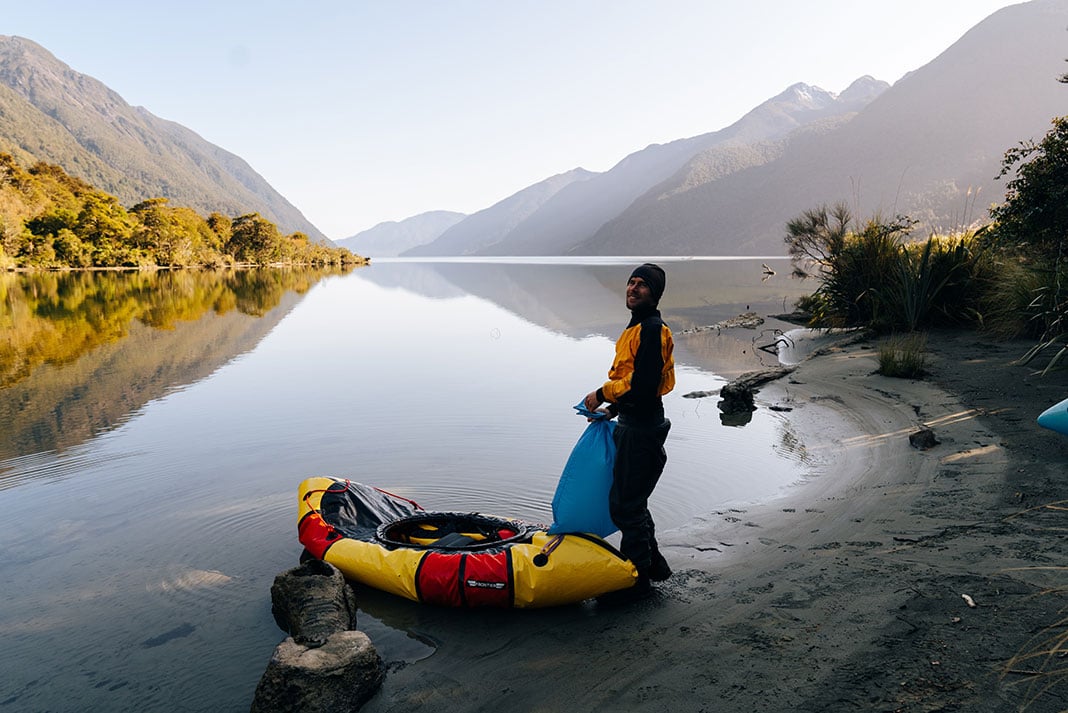
Packraft Q&A
Still have questions? Here are answers to some of the most common queries about packrafts.
-
What is a packraft?
A packraft is an ultra portable, inflatable paddling craft that can be carried in a backpack. They are used in the same way as an inflatable kayak, with a double-bladed kayak paddle. Packrafts are ultra-lightweight, with some weighing less than 10 pounds.
-
What are packrafts used for?
Packrafts can be used on all types of water—from calm lakes to whitewater rivers—for paddling outings requiring an ultra portable paddling craft. They are the best choice for remote-access, lightweight paddling expeditions and multisport outings where you want to combine trekking, cycling or ski touring with paddling.
Packrafts are also a great choice for city dwellers and anyone else who wants the most portable paddling craft for easy transportation and storage.
-
Are packrafts worth it?
A name brand packraft can cost as much as a hardshell kayak, so price is not the deciding factor for most packraft users. If you are looking for the cheapest way to get on the water, box-store inflatable kayaks and rafts will perform adequately for short, casual outings on calm waters.
But if you are looking for a durable, capable and ultra portable paddling craft that can withstand rugged and regular use on diverse waters, a packraft is well worth the investment.
-
Packrafts pros and cons
Packraft pros: lightweight, portable, small packed size, stable, much more durable than box-store inflatables; great for multisport use, expeditions and those seeking an easy way to enjoy paddlesports.
Packraft cons: lacks rigidity and performance of a hardshell kayak, slow, does not track well on flatwater, requires inflation, less interior storage for gear.
-
Inflatable kayak vs packraft
Inflatable kayaks are generally larger and heavier than a packraft. They roll up, but do not pack as small for travel as a packraft, making them less suitable for remote-access waterways. Inflatable kayaks typically have open seating areas, similar to a sit-on-top kayak. Unless rated for whitewater, most inflatable kayaks are designed for use only on calm, sheltered waters.
Packrafts roll up smaller than an inflatable kayak and are significantly lighter for easier transport in a backpack or bikepacking bag. Because of their short, wide and flat bottoms, packrafts aren’t as easy to paddle straight and have less glide than the average inflatable kayak.
Many packrafts are rated for use in moderate or even difficult whitewater. A packraft may have an open deck, like a sit-on-top kayak, or a closed deck, like a sit-inside kayak. Some decked packrafts have outfitting that allows experienced paddlers to roll them like a kayak.
-
Packraft vs kayak
Packrafts are ultra-portable, inflatable paddle craft that can roll up smaller than an inflatable kayak and are significantly lighter for easier transport to remote waterways. Compared to a hardshell kayak, packrafts are much easier to store and transport but lack the speed and handling of a plastic kayak.
-
Different types of packrafts
The two major types of packrafts are those intended for flatwater use and those designed for whitewater use. If you plan to stick to calm lakes, bays and slow-moving rivers, any open deck packraft is best. Similar to a sit-on-top kayak, they are simple, lighter and cheaper. If you’ll be paddling a mix of lakes and moderate whitewater, choose either an open deck packraft with a self-bailing floor, or a closed deck (a.k.a. whitewater deck) model.
Similar to a sit-inside kayak, some closed deck packrafts also include a spray skirt and outfitting that allows experienced paddlers to roll them just like a kayak. If you’re keen on paddling mostly difficult whitewater, choose a closed deck, whitewater-specific packraft.
-
How much does a packraft cost?
Packraft prices can be anywhere from a few hundred dollars to over $2,000. The price of the packraft depends on the quality of materials used in its construction, as well as any additional features such as a deck, outfitting, gear storage zippers, self-bailing floor or spray skirt.
-
Why are packrafts so expensive?
Packrafts are much more durable and capable than the similarly shaped inflatable rafts that are widely and cheaply available at big-box stores. If you’re looking for a portable, dependable paddling craft that can withstand rugged and regular use, a packraft is well worth the added cost.
Some packrafts are more expensive due to better quality materials and construction, and added features such as self-bailing floors, whitewater outfitting or zippered storage compartments for camping gear. Not all packrafts are expensive though. If you need a simple packraft for paddling on sheltered waterways or slow-moving rivers, you can purchase one new for a few hundred dollars.
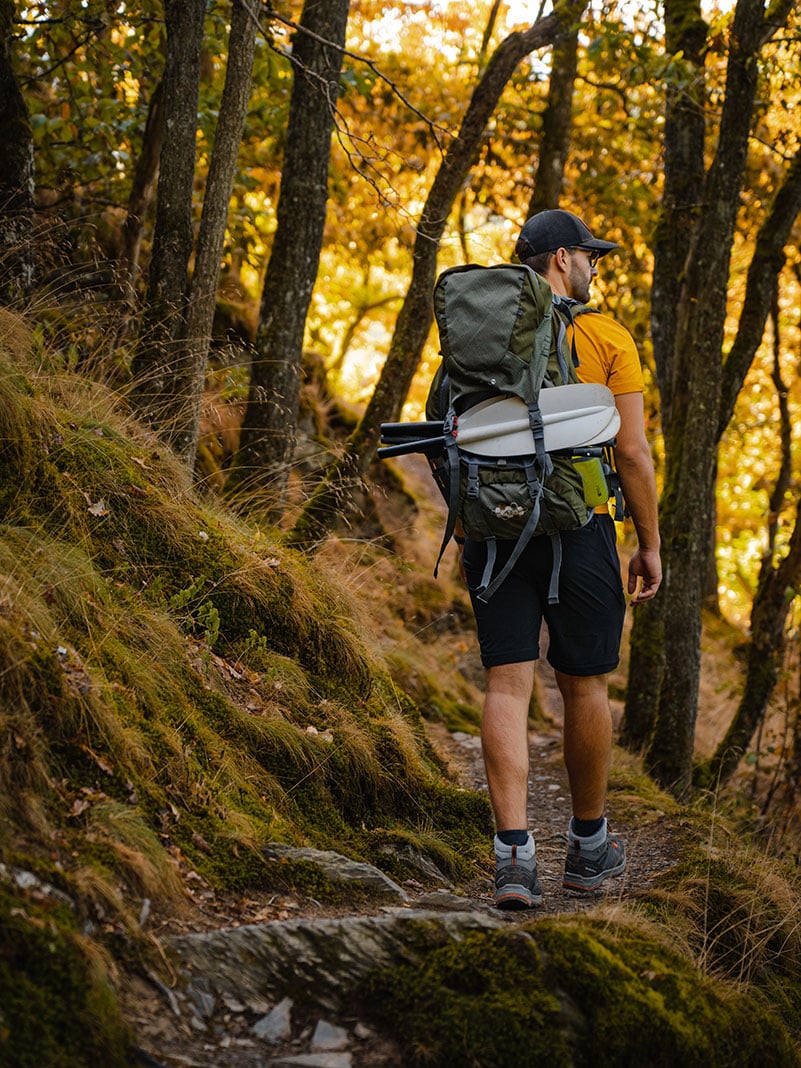
-
Packraft speed
A packraft isn’t winning any races. Packrafts are inflatable, short mini-rafts with wide, flat bottoms that are designed for stability rather than speed. A packraft will have a maximum speed of around 2–3 mph with some effort.
-
Packraft size
Packrafts come in a variety of sizes, anywhere from 6 feet to over 12 feet long, but the most common length is 7–8 feet. Most packrafts are designed to carry a single paddler and their gear, however there are also two-person tandem packrafts. Weight limits range from 250–450 pounds for a solo packraft and up to 1,000 pounds for an expedition-ready tandem; check the manufacturer’s recommended weight limit for a specific packraft’s maximum capacity.
Rolled up, a packraft can fit in a modestly sized backpack. The average weight of a packraft is 5–15 pounds, with ultralight options as low as 3 pounds and rugged expedition packrafts weighing nearly 20 pounds.
-
Packraft manufacturers
Well-known packraft manufacturers with good reputations include Kokopelli, Alpacka, NRS and Klymit among others.
-
How tough are packrafts?
Packrafts are made of abrasion- and impact-resistant materials such as reinforced, polyurethane-coated nylon. They are lightweight in layup, but still plenty durable for rugged expedition use or running whitewater rapids. Most packrafts also come with a small repair kit that can solve most leaks or minor damage within a few minutes.
-
What are packrafts made of?
Packraft materials include polyurethane-coated fabrics such as nylon, and reinforced PVC, often blended with other materials for increased durability. Packraft fabrics are lightweight but still durable. Keep in mind that the quality of the fabric and its waterproof coating will vary with the manufacturer; buy from a trusted brand for the best performance and longevity.
-
How heavy is a packraft?
Packrafts are some of the lightest paddling crafts available. The average weight of a packraft is 5–15 pounds, with ultralight options as low as 3 pounds and rugged expedition packrafts weighing as much as 20 pounds. The packraft weight depends on the construction used, and any additional features such as a self-bailing floor, whitewater deck, thigh straps or gear storage zippers.
Packraft reviews
What’s the story behind a packraft builder? How does a specific packraft perform on the water? The staff at Paddling Magazine has thoroughly reviewed a range of packrafts on the market so you can find the right one for your adventures.
Feature photo: Jason Gardner/Unsplash


